Driving the future
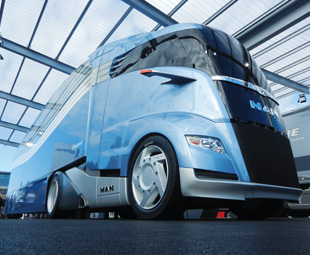
Drivers are important! And it seems that, in Europe anyway, companies are finally realising this. CHARLEEN CLARKE visits the 64th IAA Commercial Vehicles and discovers that companies are finally focusing on their most important assets …
The Germans are panicking – and not purely because of the world’s economic woes.
The slogan of this year’s show was “Commercial Vehicles – Driving the Future”. And it was rather ironic because the country is facing an imminent driver shortage, as ZF revealed at the Hanover show (which, incidentally, is now the world’s largest mobility trade fair).
The truck drivers in that country are old: about 40 percent of the 660 000 truckers in Germany are already at least 50 years of age. The average retirement age is 60 – which means that, by 2020, Germany could be faced with a shortage of some 245 000 truck drivers.
ZF and the German Fernfahrer magazine released the results of a collaborative study at the IAA, which revealed these statistics, and also conceded that the image of the transport business is “rather negative”. This poor reputation, together with “sometimes unattractive working conditions”, have exacerbated the driver shortage in Germany.
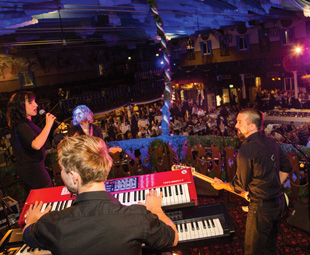 However, the industry has responded – and a theme of the IAA this year was an overwhelming focus on the driver. Yes, the green theme obviously prevailed. But, as important as the environment is, that was nothing new. The focus on the driver was. It popped up over and over again – and it’s certainly a good thing because it will make drivers happier and companies more profitable. Take MAN’s newly developed DriverPad, for instance. Trips and consignments can be processed in the logistics application, and addresses for loading and unloading can be entered straight into the integrated truck navigation system – preventing misunderstandings and circuitous routing. The driver can send free text messages … oh how life in the trucking world has changed.
However, the industry has responded – and a theme of the IAA this year was an overwhelming focus on the driver. Yes, the green theme obviously prevailed. But, as important as the environment is, that was nothing new. The focus on the driver was. It popped up over and over again – and it’s certainly a good thing because it will make drivers happier and companies more profitable. Take MAN’s newly developed DriverPad, for instance. Trips and consignments can be processed in the logistics application, and addresses for loading and unloading can be entered straight into the integrated truck navigation system – preventing misunderstandings and circuitous routing. The driver can send free text messages … oh how life in the trucking world has changed.
Yet another theme was innovation. No fewer than 354 world premieres took place at this year’s show, an IAA record – and the entire event was buzzing with optimism. Matthias Wissmann, president of the German Association of the Automotive Industry (VDA), was practically chortling with glee when he addressed the final press conference. “Never before has an IAA been as exciting as this one! Never before have we had so many new commercial vehicles – vans, heavy trucks, buses – on show as at this exhibition,” he enthused.
The number of exhibitors – 1 904 of them, from 46 countries – was nine percent higher than in 2010, while exhibition space rose by 11 percent to 260 000 m².
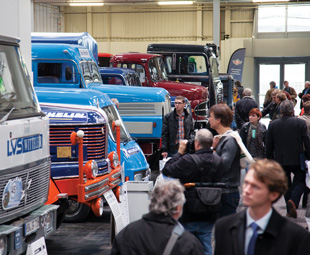 Visitor numbers also rose. “We are especially delighted that the number of visitors to the IAA showed a sharp increase. When the IAA closes its doors this evening, over 260 000 people will have visited this key trade fair. That is growth of around nine percent,” Wissmann told journalists.
Visitor numbers also rose. “We are especially delighted that the number of visitors to the IAA showed a sharp increase. When the IAA closes its doors this evening, over 260 000 people will have visited this key trade fair. That is growth of around nine percent,” Wissmann told journalists.
SIX SELLS
As could be expected, one of the key areas of focus at the show was Euro-6. Effective January 1, 2014, all newly registered trucks and buses sold in Europe must comply with the Euro-6 exhaust-gas standard. This new standard will lower nitrogen oxide emissions by 80 percent compared to Euro-5 and will reduce particulate emission by another 66 percent.
Euro-6 has, of course, meant ever-improving technology, and it was remarkable to see the proliferation of technological innovations on display. Almost all of today’s diesel trucks have common-rail systems. “The pressure in the common rail – currently up to 2 500 bar – will continue to increase, and the next target is 3 000 bar! Higher pressure means better combustion, less pollution and lower consumption!” Wissmann noted.
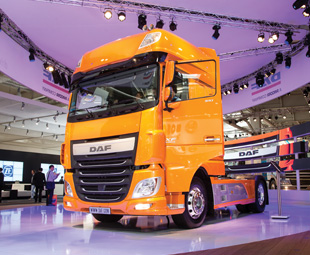 DAF was one of the companies that rolled out its Euro-6 offering in the form of the new XF. Harrie Schippers, CEO of DAF Trucks, was upbeat as he noted that revenue at Paccar was 27 percent up this year while profit was 44 percent up – largely as a result of successes outside the EU.
DAF was one of the companies that rolled out its Euro-6 offering in the form of the new XF. Harrie Schippers, CEO of DAF Trucks, was upbeat as he noted that revenue at Paccar was 27 percent up this year while profit was 44 percent up – largely as a result of successes outside the EU.
AERODYNAMICS RULES
Aerodynamics was also a key topic. And, as was especially evident on the Daimler and MAN stands, this is no longer just the vehicle manufacturer’s problem (both German manufacturers displayed trucks hooked to especially aerodynamic trailers).
Wissmann concurred: “Progress has obviously been made in the design of the front of a truck, the connection between the cab and the semi-trailer, the side covers and the rear of the trailer. The manufacturers of commercial vehicle tyres are also making important contributions to bring down the rolling resistance. Driving and rolling resistance account for 30 to 40 percent of fuel consumption – and there is significant potential for improvements in aerodynamics,” he noted.
GREEN IS STILL GOOD
As could be expected, there was huge emphasis on alternative forms of energy; this has been an IAA signature for many years now. “It is clear that the right drivetrain already exists for every purpose!” Wissmann noted.
Almost all the manufacturers had hybrid vehicles on offer – and the good news is that they are finally starting to become economically viable.
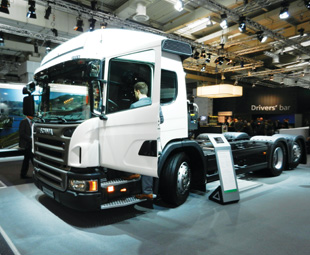 A proliferation of full electric vehicles was on offer too. Wissmann put it ever so charmingly when he pointed out that “these vans operate with zero local emissions and are so quiet they only whisper”.
A proliferation of full electric vehicles was on offer too. Wissmann put it ever so charmingly when he pointed out that “these vans operate with zero local emissions and are so quiet they only whisper”.
It is evident that Germany is extremely committed to electric mobility – in fact, the German government has set the target of having one million electric vehicles on the country’s roads by the year 2020. “By 2014 the German manufacturers will bring 15 new electrified models onto the market,” Wissmann revealed.
While this is all very good green news, the European Automobile Manufacturers’ Association (ACEA) cautioned that the benefits of the latest emission-reducing technologies would not be felt unless new vehicles are actually put on the roads.
“Europe must now make the most of the solutions brought to market by Euro-5 and -6 by helping to encourage fleet renewal,” warned DAF’s Schippers, who is also chairman of ACEA’s commercial vehicle board. “This would not only greatly and more quickly improve air quality, but would also stimulate the economy. With people holding onto their trucks for much longer than before, the average age of the fleet is rising. The significant proportion of older, more polluting Euro-0, -1, -2 and -3 trucks on the roads is obviously having a negative impact on the environment. But there is a huge potential to make a real difference.”
SAFETY REMAINS KEY
Along with the environment, safety remained an important focus. “The number of ‘assistants’ supporting the ‘boss’ – the truck driver – is increasing all the time: the emergency braking assistant, electronic stability programme (ESP), lane departure warning, and autonomous intelligent cruise control are just a few of them. Commercial vehicle manufacturers are also making faster progress and have already equipped their latest models with these intelligent aids – long before the EU requirements on ESP and driver assistance systems come into force in 2014. Naturally, it will take time before they penetrate the entire market. But as Wissmann noted: “Here in Hanover one can feel that the demand for driver-assistance systems in commercial vehicles is continuing to rise.”
GOING GLOBAL
Globalisation was another key theme at the IAA – and was characterised by the increase in foreign exhibitors (up eight percent on 2010 to 1 047) and visitors. It was astounding to see the vast numbers of Chinese, Turkish and Russian visitors at this year’s show. While the Chinese market is declining, exhibitors were unanimous in their excitement at the growth in both the Turkish and Russian markets (the latter is expected to experience double-digit growth in 2012; some exhibitors were talking about 25 percent growth this year).
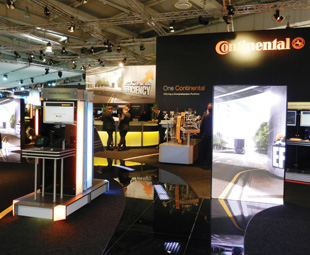 Turkey now ranks as one of the five largest commercial vehicle countries in the world. Last year, commercial vehicle production in Turkey increased by over 10 percent to
Turkey now ranks as one of the five largest commercial vehicle countries in the world. Last year, commercial vehicle production in Turkey increased by over 10 percent to
549 000 units – and according to Dr Mehmet Dudaroğlu, president of the supplier industry association Taysad, the country is on a roll. “Over the past 10 years Turkey’s economy has undergone a remarkable growth phase. The annual growth rate had been five percent between 2002 and 2011. Our export value has almost quadrupled during this period – from US$36 to 135 billion. By the end of 2023 Turkey aims to achieve an export volume of US$ 500 billion, and the automotive industry is set to contribute US$ 75 billion to this,” he noted.
It was also fascinating to learn more about the potential for the car market in that country. Dudaroğlu revealed that there are only 170 cars per 1 000 people in Turkey (versus 500 cars per 1 000 people in Germany, for instance).
And what of the much-mooted BRIC countries (alas there was no mention of BRICS). As already indicated, things aren’t looking too rosy in China. Or Brazil. According to Andreas Renschler, member of the Daimler AG Board of Management responsible for Daimler trucks and buses, the Brazilian market will experience a decline of at least 15 percent this year.
As is characteristic of this captain of industry, Roberto Cortes, president and CEO of MAN Latin America, was realistic yet positive about prospects in that market. “The commercial vehicle market has declined by 20 percent but we are confident that the economy will pick up and that sales will improve,” he said. Cortes revealed that the Brazilian government had introduced a
75 percent reduction in the interest rate for capital goods, and said he believed this would boost the market.
 The fourth member of the BRIC family – India – has its own set of challenges. “The Indian commercial vehicle market is reflecting the weaker economic growth currently being recorded in that country and is therefore developing at a slower rate,” Renschler revealed. “Nevertheless, there already exists a new government subsidy programme to stabilise demand. An economic stimulus plan for large infrastructural projects is also on the way.”
The fourth member of the BRIC family – India – has its own set of challenges. “The Indian commercial vehicle market is reflecting the weaker economic growth currently being recorded in that country and is therefore developing at a slower rate,” Renschler revealed. “Nevertheless, there already exists a new government subsidy programme to stabilise demand. An economic stimulus plan for large infrastructural projects is also on the way.”
THE FUTURE LOOKS GOOD
As stated at the outset, the slogan of this year’s fair was “Commercial Vehicles – Driving the Future”. As such, there was considerable emphasis on the vehicle of the future. Clearly it will be safe and green. But it will also be ever so clever, Dr Ulrich Eichhorn, managing director of the VDA, revealed. “The automotive industry is about to take a new innovative leap forward. The vehicle of the future will be networked – with the environment, with the traffic infrastructure and with the world of the internet,” he explained.
With the aid of sensors, vehicles can already absorb a large amount of information from their surroundings. “But they don’t yet see further than the radar sensor of the distance-regulation system,” said Eichhorn. “In future, though, the vehicle will be able to tell the driver what lies around the next bend or behind a hilltop. Developers are making use of the sensors of vehicles travelling ahead to pass on this information backwards like an electronic chain letter.”
Future assistance systems will also make the driver’s life a bit easier. “For instance, video cameras will observe other road users and identify their intentions,” he said.
It’s clear that we have a lot to look forward to …
· The 65th IAA Commercial Vehicles will take place in Hanover, Germany, from September 25 to October 2, 2014.
Published by
Focus on Transport
focusmagsa




